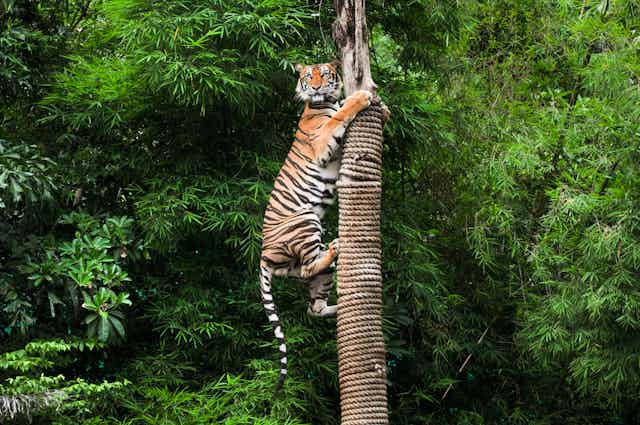The sad death of a tiger keeper at Hamerton Zoo in Cambridgeshire, England, has led some to question whether this accident was related to the amount of space the captive tigers had access to.
Some critics of zoos have pointed out that tigers can range over thousands of square kilometres in the wild rather than the few thousand square metres they are provided with in captivity. This is true. But despite being able to roam over such large distances wild tigers still kill significant numbers of people every year. Therefore, I would argue that the quantity of space argument is a fallacious one. What matters is the quality of the space.
There is, of course, a minimum space requirement that animals need to experience good welfare, and no tiger should ever be kept in a small cage. But once this minimum has been met, the animal needs space it can utilise meaningfully.
Think about sitting in the seat of a low-cost airline. It is uncomfortable, cramped, boring and almost bearable for a short journey, but not for the rest of your life. At the other extreme, in a first-class airline suite, you are provided with everything you could possibly want – gourmet food, more space, a bed, unlimited entertainment, a shower, and so on. A much longer and more pleasant life would definitely be sustainable in this situation.
The reality is that good zoos are more like first-class airline cabins than budget carriers. This is not to deny the existence of awful zoos; my point is that it is perfectly possible for a tiger to live a long and happy life in the right sort of captivity.
It doesn’t require pampering. Zoo animals are already becoming obese just like humans in richer societies and for the same reasons – too much energetic food and not enough exercise. For this reason, good zoos have been providing objects or enclosure fittings to stimulate natural behaviour.
In good zoos throughout the world, you will no longer see a tiger receiving all of its food in a bowl, but instead some of its food will be suspended by a rope from its enclosure’s roof or placed on the top of a pole. Thus tigers, like most zoo animals, now need to work for a living.

But would tigers choose to work for a living? This is a good question we don’t truly know the answer to, which is why animals should be encouraged to engage with environmental enrichment – but not forced.
Tigers don’t wander for the sake of it
What we do know is that optimal foraging theory suggests tigers don’t really want to range over thousands of square kilometres.
Scientists have spent many decades looking at how animals search for food. And the consistent result that has come out of the hundreds of studies is that animals try and spend the minimum amount of time or energy for the maximum amount of food reward. That is, animals act like logical consumers and try to maximise their cost-benefit ratio.
Returning to our tiger, it ranges over thousands of kilometres because that is the distance necessary to find all the resources it requires to survive. If resources such as food were more densely distributed then wild tigers would roam over much smaller distances. You can see this playing out in the wild, where tiger ranging distance depends on the density of their prey. In Siberia, each individual covers a vast distance as the deer they eat are few and far between, while the lush forests and marshlands of northern India can sustain many more tigers in the same sized area.

My zoo designer friends would rightly point out to me that it is easier to create more complex and interesting space in a larger area. I wholeheartedly agree. However, I personally feel that legislating minimum space requirements is not a good solution, as these minimums become the de facto norm. Such regulations could also stop the implementation of new housing systems such as the Zoo360 animal exploration trails at Philadelphia Zoo, where animals are able to move around the zoo and chose their environment.
Many studies have shown that captive animals enjoy this kind of novelty, and this is one of the reasons environmental enrichment improves animal welfare. But it must be novelty over which the animals have some control – a constantly changing environment can be as stressful as a barren, unchanging one. Variety is only the spice of life when you are in control of it.

